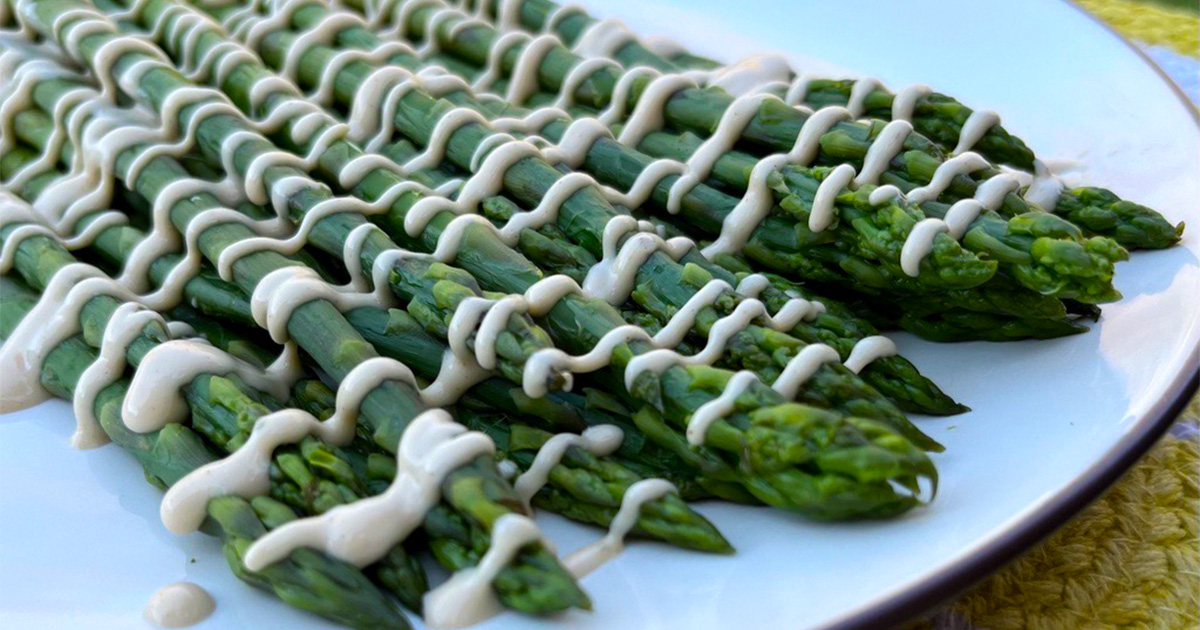- 855.224.8655
- Schedule a Tour

This month, we’re highlighting the benefits and versatility of ASPARAGUS! Our goal with each new vegetable spotlight is to encourage adventurous, healthy eaters at school and at home. Through exposure to Veggies Early & Often, we know children can learn to love them in support of a lifetime of good choices. Leading by example is important too!
Asparagus is a healthy addition to your menu. It’s rich in many vitamins (including A and C), minerals, and folic acid. Asparagus also provides a good amount of fiber to support gut health. As with any high-fiber selection, it’s important to make sure you’re drinking enough water to support digestion.
Asparagus is sold fresh, frozen, and canned.
When purchasing fresh asparagus from the produce section, look for stalks that are firm and smooth. Avoid stalks that appear limp, wilted, or wet. The tips of the asparagus should be closed or compact. When prepping fresh asparagus, remove the woody ends. You can use a knife or by snapping the ends off where it naturally breaks. Kids especially enjoy helping with this step!
Frozen asparagus maintains its nutritious benefits, color, and flavor, making it an easy option to keep on hand during any season. Frozen asparagus can be substituted in most recipes and is a great option when fresh asparagus is unavailable.
Canned asparagus loses its vibrant green color during the canning process. It also typically has added sodium. However, if given the choice to eat no asparagus or canned asparagus, eating the canned version is still worthwhile. It will have a softer texture than fresh or frozen options. It’s still a great source of vitamins, minerals, and fiber too!
Try one of these three Grow Fit®-approved recipes with your family:
Creamy Dijon Asparagus (Serves 4)
Ingredients:
1 lb. asparagus, bottoms trimmed
1 Tbsp. Dijon mustard
¼ cup mayonnaise
1 lemon wedge
Directions:
- Add 1 inch of water to a shallow skillet with a lid. Bring to a boil.
- Add the asparagus. Cover with lid and cook for 3 to 4 minutes.
- In a small bowl, combine the mayonnaise, Dijon mustard, and squeeze of lemon juice.
- Transfer the asparagus to a serving platter.
- For young assistants: Have your child spoon the Dijon sauce on top of the asparagus.
Chilled Asparagus with Citrus Vinaigrette (Serves 4)
Ingredients:
1 lb. asparagus, bottoms trimmed
1 tsp. orange zest
¼ cup orange juice
2 Tbsp. lemon juice
1 Tbsp. Dijon mustard
2 tsp. white wine vinegar
1 Tbsp. olive or avocado oil
2 tsp. honey
Directions:
- Bring a large pot of water to a boil. Add the asparagus and cook for 2 minutes. Immediately remove the asparagus and place it in an ice bath.
- Once the asparagus is cool, remove it from the water. For young assistants: Have your child pat the asparagus dry by blotting it with a paper towel.
- Combine the remaining ingredients in a small mixing bowl. For young assistants: Whisk it all together to make the vinaigrette.
- Pour the vinaigrette over the asparagus and toss to coat. Cover and refrigerate until ready to serve.
Spring Asparagus Frittata (Serves 4)
Ingredients:
2 Tbsp. unsalted butter
½ cup red onions, diced
1 lb. asparagus, bottoms trimmed
½ cup frozen peas
6 large eggs
¾ cup light cottage cheese
1 Tbsp. minced chives
¼ tsp. tarragon
1 cup Italian blend shredded cheese
Directions:
- Cut asparagus into one-inch pieces.
- Heat butter in a 10-inch, oven-proof frying pan over medium heat.
- Cook the onions until they are soft and translucent (approximately 3 minutes).
- Add the asparagus and cook for an additional 3 minutes.
- Stir in the peas allowing them to soften.
- Preheat your oven to the broiler setting.
- Beat the eggs and cottage cheese together. For young assistants: Have your child stir in the chives and tarragon.
- Pour the egg mixture into the pan and cook until almost set (about 5 minutes). Note: It will still be runny.
- Sprinkle the cheese on top and put the pan in the oven to broil for 6 to 8 minutes or until the center is set. When done, the cheese should be melted and browned.
- Cut into wedges to serve.

*These recipes are all veggie-forward and approved by the Partnership for a Healthier America to meet the Veggies Early & Often guidelines. Approved 4/3/23.

 Childhood nutrition has been Nicole’s passion for more than 20 years. She is a Registered Dietitian Nutritionist (RDN) with a Master of Science (MS) in Nutrition and Dietetics from Northern Illinois University. During her career with Learning Care Group (LCG), Nicole has assisted with developing and implementing the company’s proprietary Grow Fit program. Through her curated menus, the healthy lifestyle initiative positively impacts approximately 100,000 children daily in LCG’s 1,050+ schools. She aided in the rollout of the Veggies Early & Often campaign in 2021 and helped LCG be recognized as the 2017 Partner of the Year by the Partnership for a Healthier America. Since 2004, she’s also been an active Junior League member and developed the Kids in the Kitchen program for their Detroit and Milwaukee chapters. Nicole and her husband, John, have three children. In her spare time, Nicole competes on a rowing team with the Detroit Boat Club Crew.
Childhood nutrition has been Nicole’s passion for more than 20 years. She is a Registered Dietitian Nutritionist (RDN) with a Master of Science (MS) in Nutrition and Dietetics from Northern Illinois University. During her career with Learning Care Group (LCG), Nicole has assisted with developing and implementing the company’s proprietary Grow Fit program. Through her curated menus, the healthy lifestyle initiative positively impacts approximately 100,000 children daily in LCG’s 1,050+ schools. She aided in the rollout of the Veggies Early & Often campaign in 2021 and helped LCG be recognized as the 2017 Partner of the Year by the Partnership for a Healthier America. Since 2004, she’s also been an active Junior League member and developed the Kids in the Kitchen program for their Detroit and Milwaukee chapters. Nicole and her husband, John, have three children. In her spare time, Nicole competes on a rowing team with the Detroit Boat Club Crew.